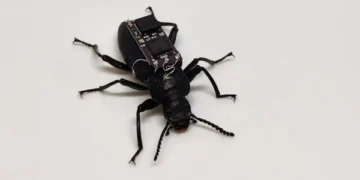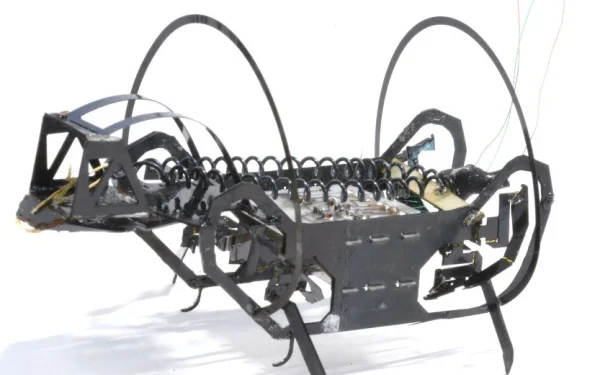Introduction: The Challenge of Miniature Mobility
As robotic technologies evolve, miniaturized robots are gaining increasing attention for their potential applications in surveillance, search and rescue, and environmental monitoring. However, designing small robots capable of effectively navigating natural and unstructured environments remains a significant engineering challenge. Most microbots struggle with obstacles such as uneven terrain, gaps, and debris. To address these challenges, engineers at Harvard University’s Wyss Institute for Biologically Inspired Engineering have unveiled a groundbreaking microbot that combines walking and jumping capabilities, enabling it to traverse complex terrain with remarkable agility.
Inspired by Nature: The Springtail Insect
The design of this innovative microbot draws inspiration from one of nature’s most agile and gymnastic insects—the springtail. Springtails are tiny soil-dwelling organisms that possess a unique escape mechanism: they can catapult themselves into the air in a fraction of a second using a specialized structure called a furcula. This ability allows them to evade predators quickly and effectively. Harvard’s team of engineers used this natural model to develop a robot that can mimic such rapid movements while maintaining control.
Engineering Marvel: Design and Capabilities
Led by Professor Robert Wood, head of the Harvard Microrobotics Laboratory, the team developed a palm-sized robot equipped with legs that can both walk and jump. This dual-mode of locomotion offers both precision and agility. Walking allows for controlled, stable movement over flat or moderately rough terrain, while jumping enables the microbot to overcome larger obstacles that would otherwise be impassable.
“Jumping provides a powerful method for traversing gaps or climbing over obstructions,” said Professor Wood. “However, it can also be unpredictable and harder to control. By combining it with walking, we can achieve a hybrid approach that is far more effective in real-world environments.”
The Mechanism Behind the Motion
The microbot utilizes a spring-loaded mechanism for jumping, inspired by the springtail’s furcula. This mechanical system allows the robot to store and release energy quickly, enabling rapid bursts of movement. For walking, the robot uses tiny actuators that provide slow but controlled steps. The combination of these two systems allows the microbot to adapt to a wide range of terrain types, from smooth surfaces to rocky, uneven ground.
In addition, the robot’s frame is constructed from lightweight yet durable materials, ensuring it can withstand multiple jumps without sustaining damage. Its compact size also makes it suitable for deployment in confined or hazardous areas where larger robots cannot operate.
Applications and Potential Uses
The implications of this technology are far-reaching. With the ability to navigate complex environments, these microbots could be deployed in a number of fields:
- Search and Rescue: In disaster zones where rubble and debris hinder access, these robots could be used to locate survivors or deliver essential supplies.
- Environmental Monitoring: In forests, wetlands, or caves, microbots could gather data on soil quality, humidity, or chemical presence.
- Medical Applications: Miniature robots with similar designs could be developed for internal diagnostics or targeted drug delivery in the human body.
- Military and Defense: For reconnaissance missions in difficult terrains, such robots could provide stealth and agility.
Future Enhancements and Research
While the current version of the microbot represents a significant breakthrough, the researchers are already planning further enhancements. Potential upgrades include adding sensors for navigation and environmental mapping, incorporating wireless communication modules, and integrating power-efficient energy storage systems.
Another focus of ongoing research is improving the precision and control of the jump mechanism. The goal is to make the jumps more predictable and customizable based on the environment, ensuring that the robot lands on its intended target rather than being thrown off course.
Environmental and Ethical Considerations
As with all emerging technologies, especially those inspired by biological organisms, ethical considerations are essential. Researchers at Harvard have emphasized the importance of using this technology responsibly. They also advocate for the use of sustainable materials and energy-efficient components to minimize the environmental impact of these robots.
Conclusion: A Leap Forward in Robotics
The development of a microbot that can jump like an insect and walk with precision represents a significant advancement in the field of robotics. Inspired by the natural agility of springtails, Harvard engineers have successfully mimicked one of nature’s most effective survival mechanisms in a robotic form. This innovation opens up new possibilities for the deployment of micro-scale robots in real-world applications, from saving lives in disaster zones to exploring the depths of the Earth’s ecosystems. As research continues, we can expect even more sophisticated versions of this technology, pushing the boundaries of what tiny robots can achieve.

























